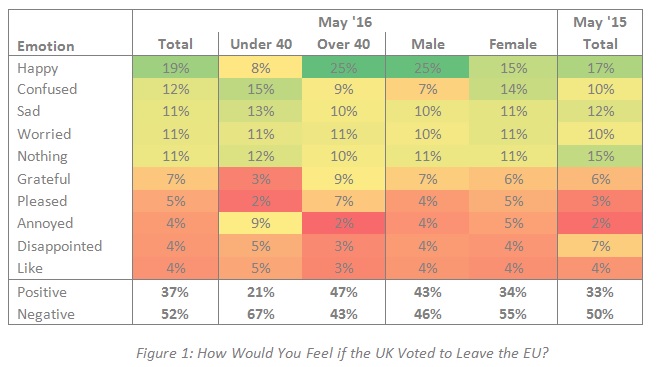Emotalizer: Leaving the European Union – An Update
Posted: 02/06/2016

“Happy? Worried? Or just plain confused? With just three weeks to go, we revisit the British public’s emotional reaction to Brexit”

With the EU Referendum now just three weeks away, and with politicians and media coverage overwhelming the British public with the potential consequences of either outcome, we revisited the topic that we first examined last May to see how a year of campaigning has impacted public opinion.
The most recent poll, run on May 24th by Survation, shows the Remain camp to have a lead with 44%, Leave at 38% and 18% of voters still undecided. But the polls still vary widely and there’s increased public scepticism around polling figures following their poor prediction of the General Election 2015. This leaves people looking elsewhere for a more reliable indication of the result.
Last year we looked at the issue through the more colourful lens of people’s emotional reactions to a Brexit, and found the most commonly cited emotion to be Happiness. Overall, however, only 33% of the sample cited positive emotions and 50% cited negative emotions including Sadness, Disappointment and Worry.
Revisiting these provoked emotions a year later we find Happiness is still the most common emotional reaction. There has been a slight increase in the proportion of positive emotions, but this is still lower than the proportion citing negative emotions and these specific negative emotions have remained consistent.
In our previous post on the topic we noted that worry about leaving the EU and disrupting the status quo would play a significant role. In effect, anxiety will convert people who said they’d vote Brexit once they are alone in the polling booth and will sway the undecided voters. The current Remain campaign’s scaremongering approach is the right strategy to activate these fears.
As the referendum gets closer we see fewer disengaged respondents citing no emotion about the topic. In our May ‘15 research younger respondents and women were particularly apathetic, but both groups have become more engaged in this round of testing. Despite, or indeed because of, the increasing media coverage the proportion citing confusion has increased by 2%.
In this round we also asked respondents whether they were planning to vote and found that 84% were indeed planning to vote and those who weren’t were either apathetic or confused.